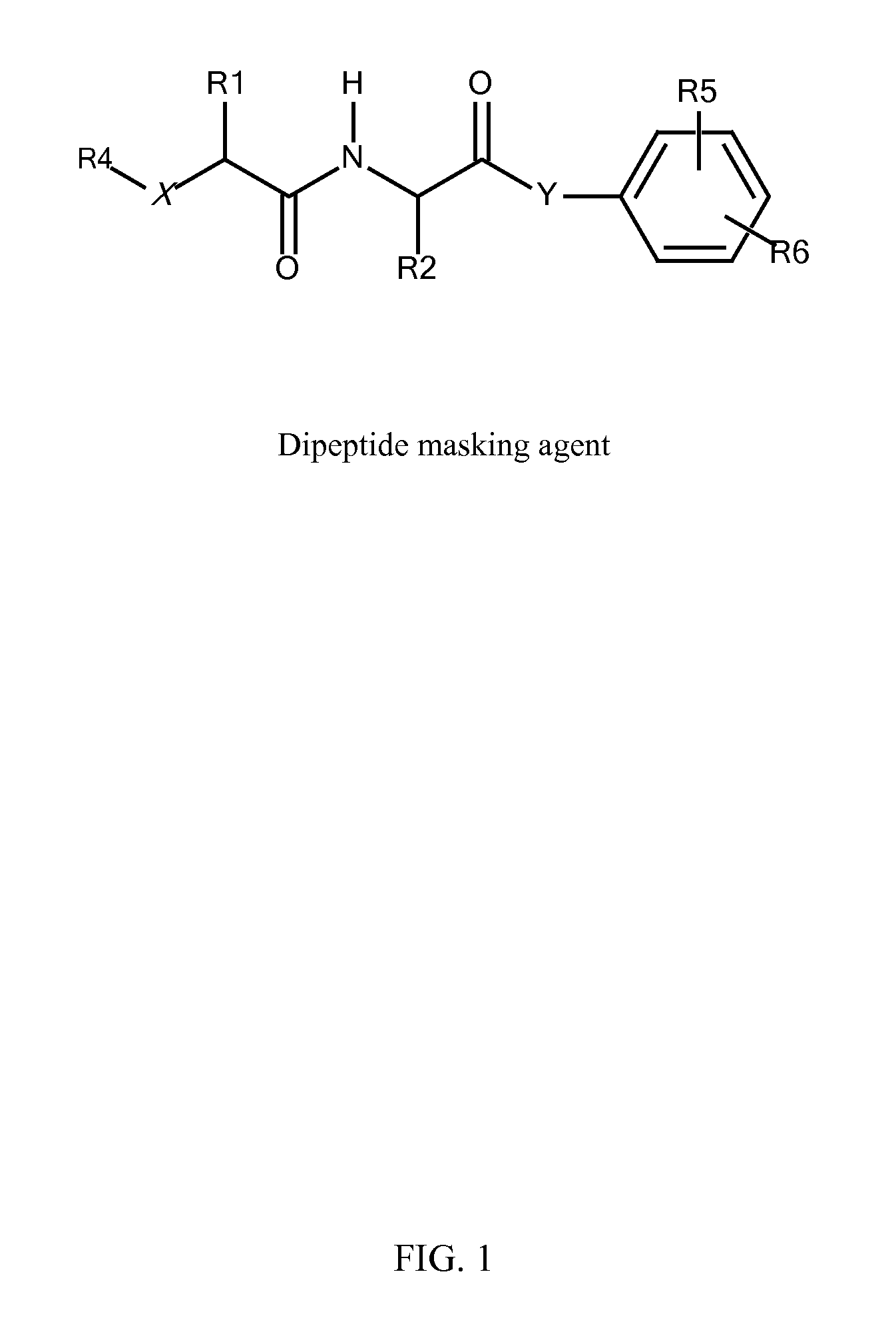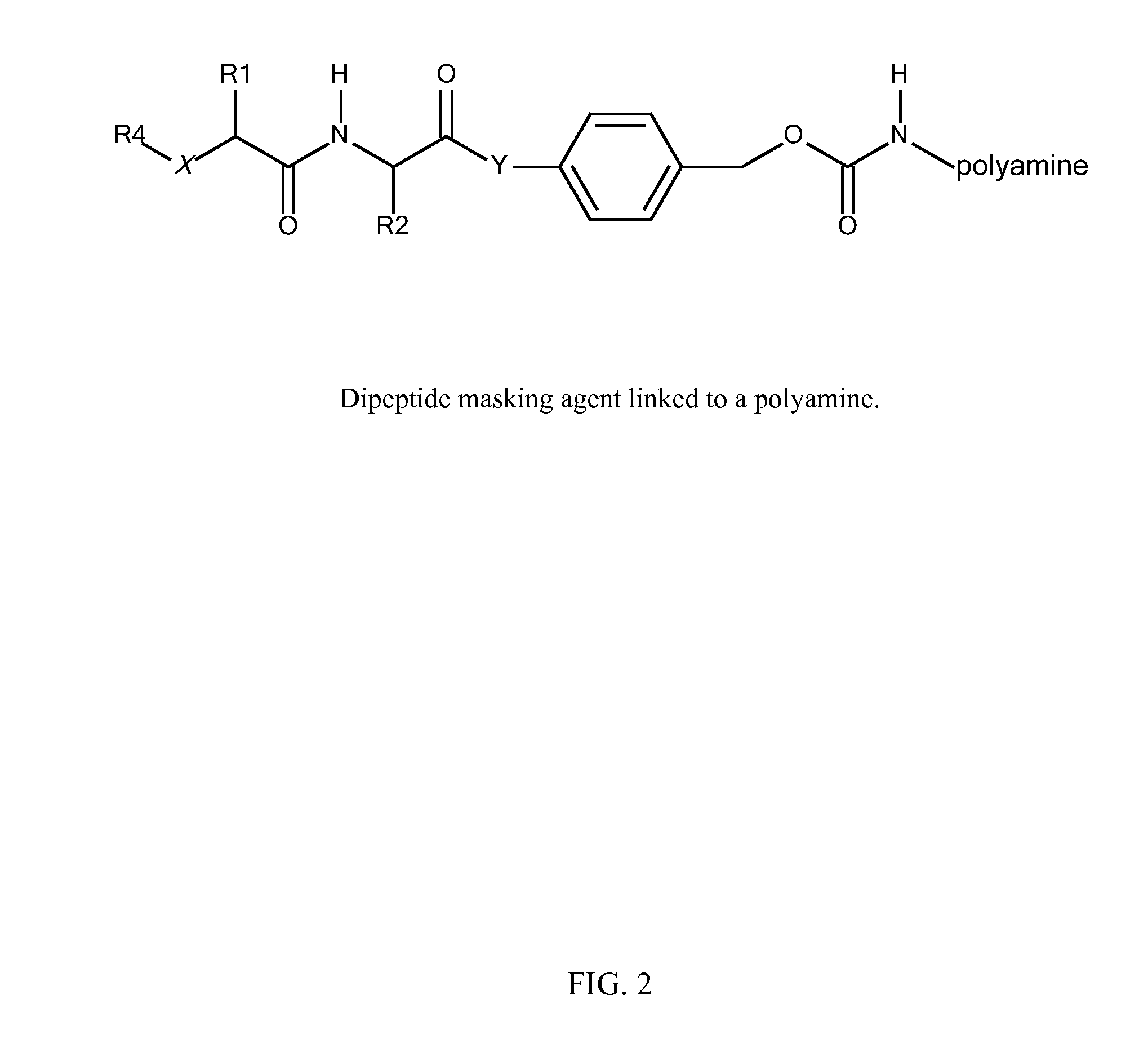In Vivo Polynucleotide Delivery Conjugates Having Enzyme Sensitive Linkages
- Summary
- Abstract
- Description
- Claims
- Application Information
AI Technical Summary
Benefits of technology
Problems solved by technology
Method used
Image
Examples
example 1
Synthesis of Protease (Peptidase) Cleavable Masking Agents
[0153]All reactions, except coupling of amino acids in aqueous NaHCO3 and silyl-group deprotection, were carried out in anhydrous conditions using fresh anhydrous solvents. Column purification was done on a silica gel using specified eluents. Mass-spectra (MS) were taken using electrospray ionization.
[0154]In preparation of active p-nitrophenyl-p-acylamidobenzyl carbonate derivatives of NAG and PEG (NAG-L-AA-PABC-PNP and PEG-AA-PABC-PNP) we utilized NHS ester of respective PEG or NAG-containing derivatives to acylate amino terminus of dipeptido-p-acylaminobenzy alcohol precursor. In the following steps benzylic hydroxyl group was converted into p-nitrophenyl carbonate followed by removal of protective groups from amino acids and NAG moiety. In some applications, when paranitrophenol (PNP)-carbonates were used for modification of certain polymers, protective groups prior to polymer modification.
R comprises an ASGPr ligand (pro...
example 2
Linkage of Protease Cleavable Masking Agents to Amine-Containing Polymers—Formation of P-Acylamidobenzyl Carbamate Linkages
[0310]A. Modification of Melittin with protease cleavable masking agents. 1×mg of melittin peptide and 10×mg HEPES base at 1-10 mg / mL peptide was masked by addition of 2-6×mg of amine-reactive p-nitrophenyl carbonate or N-hydroxysuccinimide carbonate derivatives of the NAG-containing protease cleavable substrate. The solution was then incubated at least 1 h at room temperature (RT) before injection into animals.
[0311]B. Modification of polyamines with protease cleavable masking agents. Activated (amine reactive) carbonates of p-acylamidobenzyl alcohol derivatives are reacted with amino groups of amphipathic membrane active polyamines in H2O at pH>8 to yield a p-acylamidobenzyl carbamate.
R1 comprises an ASGPr ligand (either protected or unprotected) or a PEG,
R2 is an amphipathic membrane active polyamine,
AA is a dipeptide (either protected or unprotected), and
Z i...
example 3
siRNAs
[0313]siRNAs had the following sequences
Factor VII siRNAsense:(Seq ID 1)(Chol)-5′ GfcAfaAfgGfcGfuGfcCfaAfcUfcAf(invdT) 3′antisense:(Seq ID 2)5′ pdTsGfaGfuUfgGfcAfcGfcCfuUfuGfcdTsdT 3′orsense:(Seq ID 3)5′ GGAUfCfAUfCfUfCfAAGUfCfUfUfACfdTsdT 3′antisense:(Seq ID 4)5′ GUfAAGACfUfUfGAGAUfGAUfCfCfdTsdT 3′orsense:(Seq ID 5)(NH2C6)GfuUfgGfuGfaAfuGfgAfgCfuCfaGf(invdT) 3′antisense:(Seq ID 6)pCfsUfgAfgCfuCfcAfuUfcAfcCfaAfcdTsdT 3′orsense:(Seq ID 23)5′ (NH2C6)uGuGfcAfaAfgGfcGfuGfcCfaAfcticAf(invdT) 3′antisense:(Seq ID 24)5′ pdTsGfaGfuUfgGfcAfcGfcCfuUfuGfcdTsdT 3′Factor VII siRNA(primate)sense:(Seq ID 7)(chol)-5′ uuAGGfuUfgGfuGfaAfuGfgAfgCfuCfaGf(invdT) 3′antisense:(Seq ID 8)5′ pCfsUfgAfgCfuCfcAfuUfcAfcCfaAfcdTsdT 3′ApoB siRNA:sense:(Seq ID 9)(cholC6SSC6)-5′ GGAAUCuuAuAuuuGAUCcAsA 3′antisense:(Seq ID 10)5′ uuGGAUcAAAuAuAAGAuUCcscsU 3′AhaI siRNA:sense:(Seq ID 11)(NH2C6)GfgAfuGfaAfgUfgGfaGfaUfuAfgUf(invdT) 3′antisense:(Seq ID 12)pdAsCfuAfaUfcUfcCfaCfuUfcAfuCfcdTsdT 3′Luc siRNAsense:(Seq ID 1...
PUM
| Property | Measurement | Unit |
|---|---|---|
| Fraction | aaaaa | aaaaa |
| Volume | aaaaa | aaaaa |
| Volume | aaaaa | aaaaa |
Abstract
Description
Claims
Application Information
 Login to View More
Login to View More - R&D Engineer
- R&D Manager
- IP Professional
- Industry Leading Data Capabilities
- Powerful AI technology
- Patent DNA Extraction
Browse by: Latest US Patents, China's latest patents, Technical Efficacy Thesaurus, Application Domain, Technology Topic, Popular Technical Reports.
© 2024 PatSnap. All rights reserved.Legal|Privacy policy|Modern Slavery Act Transparency Statement|Sitemap|About US| Contact US: help@patsnap.com










